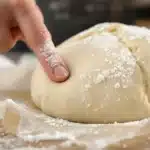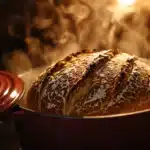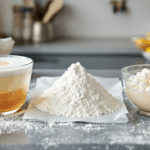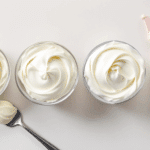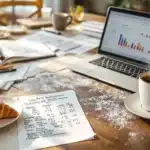You’ve followed the recipe to the letter, mixed everything just so, preheated the oven perfectly, yet your cake came out dry, your cookies spread too much, or your bread is disappointingly dense. What went wrong? While baking involves many variables, one of the most common yet often overlooked culprits lies in the very first step: measuring your ingredients. Specifically, relying solely on volume measuring cups, especially for dry ingredients like flour, can introduce significant inaccuracies that sabotage your efforts before you even start mixing.
For many aspiring bakers accustomed to cooking by “feel” or using traditional cup measures, the idea of weighing ingredients might seem fussy or unnecessary. “My grandmother never used a scale!” is a common refrain. But baking operates much more like chemistry than intuitive cooking. Precise ratios are paramount, and the seemingly innocent measuring cup can be a source of major inconsistency. It’s time to make the case that for anyone serious about improving their baking and achieving reliable, repeatable results, ditching the scoop-and-hope method and embracing a digital kitchen scale isn’t just helpful – it’s truly non-negotiable.
The Problem with Volume: Why Cups Can Cause Chaos
Why are volume measurements, particularly cups, so problematic for baking accuracy? It boils down to density and compaction.
- The Flour Compaction Conundrum: Flour is the prime example. Its volume can change dramatically depending on how it’s handled:
- Scooped Flour: Dipping your measuring cup directly into the flour bag or canister compacts the flour significantly. This method routinely packs 20-30% more flour (by weight) into the cup than intended by most recipe developers.
- Spooned Flour: Gently spooning flour into the cup and then leveling it off results in a much lighter, less compacted measure.
- Sifted Flour: Sifting incorporates air, making the flour even less dense by volume.
- The Result: The same 1 cup measure could contain anywhere from 110 grams to over 160 grams of flour depending on how you fill it! This massive variation completely throws off the critical hydration ratio (flour-to-liquid balance) in your recipe, leading directly to common problems like dryness, density, toughness, or poor rise.
- Varying Ingredient Densities: Different dry ingredients have different weights for the same volume. A cup of granulated sugar weighs significantly more than a cup of all-purpose flour, which weighs more than a cup of confectioners’ sugar or cocoa powder. Relying on volume assumes a consistency that simply doesn’t exist across ingredients.
- Recipe Ratio Roulette: Successful baking depends on the precise ratios between ingredients – flour provides structure, liquids hydrate, fats tenderize, sugar sweetens and moistens, leaveners lift. When you measure inaccurately by volume, you unknowingly alter these crucial ratios, making the outcome unpredictable. That’s why the same recipe might work one day and fail the next.
- International Inconsistencies: Even the definition of a “cup” can vary slightly between countries (US cup vs. Metric cup vs. Imperial cup). Weight units like grams and ounces, however, are universal standards.
Relying on volume measurements, especially for flour, is like trying to build a stable structure with measuring tapes that stretch and shrink unpredictably. You might get lucky sometimes, but consistency is impossible.
Enter the Scale: The Power of Measuring by Weight
Measuring ingredients by weight using a digital kitchen scale eliminates all the variability and guesswork associated with volume cups. It is the universally preferred method used by professional bakers and reliable recipe developers for several compelling reasons:
- Unbeatable Accuracy: Weight is an absolute measure. 100 grams of flour is always 100 grams of flour, regardless of whether it’s packed down, fluffed up, or sifted. It removes all ambiguity and ensures you are using the precise amount of each ingredient the recipe intended.
- Ironclad Consistency: By using the exact same weight of ingredients every time you make a recipe, you guarantee that the crucial ratios remain constant. This leads to dramatically more consistent, repeatable, and reliable baking results. No more mystery failures!
- Universality & Recipe Access: Grams and ounces are standard units worldwide. Using a scale allows you to confidently use recipes from international sources or professional bakers who almost exclusively provide weight measurements.
- Precise Control & Adjustments: Want to slightly reduce the sugar? Calculating 80% of the weight is far more accurate than trying to guess 80% of a cup. Need to perfectly scale a recipe up by 50% or down by half? Weight makes the math simple and precise. It also opens the door to understanding baker’s percentages for bread making, which rely entirely on weight ratios.
Using a scale takes the biggest source of random error out of your baking equation, allowing you to focus on technique and flavor.
Beyond Accuracy: Other Benefits of Using a Scale
The advantages of weighing ingredients extend beyond just better baking results:
- Significantly Less Cleanup! (Meet the Tare Button): This is a game-changer. Almost all digital scales have a “tare” or “zero” function. Here’s how it works:
- Place your empty mixing bowl on the scale.
- Press the “tare” button. The display resets to zero, ignoring the bowl’s weight.
- Add your first ingredient (e.g., flour) directly into the bowl until you reach the target weight.
- Press “tare” again. The display resets to zero.
- Add your next ingredient (e.g., sugar) directly into the same bowl until you reach its target weight.
- Press “tare” again… and so on. You can often measure almost all your ingredients directly into one or two bowls, eliminating the need for washing numerous measuring cups and spoons!
- Increased Efficiency: Once you get the hang of it, measuring directly into the bowl using the tare function is often faster and less fussy than dirtying and leveling off multiple cups and spoons.
- Better Recipe Intuition: Consistently working with weights helps you develop a better feel for ingredient ratios and how they function, leading to a deeper understanding of recipe structure and formulation over time.
Choosing Your Scale: What to Look For
Convinced? Great! The good news is that reliable digital kitchen scales are remarkably affordable and readily available. Here’s what to look for when choosing one:
- Digital Display: Opt for a digital scale over an old-fashioned spring/mechanical scale. Digital displays are easier to read accurately and are necessary for the crucial tare function.
- Capacity: Ensure the scale can handle the weight of your heaviest mixing bowl plus the ingredients you’ll typically use. A capacity of around 5 kilograms (or 11 pounds) is usually more than sufficient for home baking needs.
- Precision (Increments): Look for a scale that measures in small increments, ideally 1 gram or 0.05 ounces. Avoid scales that only measure in larger jumps (e.g., 5 or 10 grams), as they lack the necessary precision for baking.
- Multiple Units: The scale must be able to easily switch between measuring in grams (g) and ounces (oz)/pounds (lb). Reliable recipes may use either system.
- Tare/Zero Function: This is essential. Ensure the scale has a dedicated button to zero out the weight of containers or previously added ingredients.
- Platform Size: Choose a scale with a platform large enough to comfortably accommodate your most frequently used mixing bowls without obscuring the display.
- Readability: Select a scale with a clear, bright display that is easy to read, even with a large bowl on the platform. A backlit display can be helpful in lower light conditions.
- Ease of Cleaning: A smooth surface without too many crevices and sealed buttons make wiping the scale clean much easier.
- Power Source: Most are battery-operated. Check the type of batteries required and consider models with an auto-shutoff feature to conserve power (but ensure it doesn’t shut off too quickly while you’re measuring!).
- Cost: You don’t need to spend a fortune. Excellent, reliable digital kitchen scales suitable for baking are widely available in the $15-$30 price range.
Overcoming Resistance: “But Measuring Cups Worked for Grandma!”
It’s true that generations baked wonderful things using volume cups. So why the push for scales now?
- Consistency was Different: Traditional recipes passed down orally or handwritten often relied on practiced technique and intuition gained over years. The baker likely used the same cups and the same flour, and instinctively adjusted based on humidity or feel – skills less common today. Furthermore, flour milling and consistency have also changed over time.
- Hidden Adjustments: Experienced bakers using cups often subconsciously adjusted scoop density or added slightly more/less liquid based on how the dough felt, compensating for volume inaccuracies without explicitly stating it.
- Science & Professionals: As baking science has become better understood, the importance of precise ratios is clear. Virtually all professional bakers and pastry chefs rely exclusively on weight for accuracy and consistency. Reliable modern recipe developers do too.
- Empowerment, Not Disrespect: Using a scale isn’t about dismissing tradition; it’s about embracing a tool that provides greater control, predictability, and reduces frustrating failures. It actually makes baking easier and more reliable in the long run, allowing you to focus on technique and creativity instead of battling inconsistent ingredient amounts.
Think of it as upgrading from estimating distance by eye to using a precise measuring tape – it simply gives you better, more repeatable results.
Conclusion: Scale Up for Baking Success
While measuring cups have their place for liquids or less critical volume additions, they are an inherently flawed and inconsistent tool for measuring key dry ingredients in baking, especially flour. The variability introduced by volume measurements is a leading cause of common baking problems, from dry cakes to dense breads.
Making the switch to a digital kitchen scale is arguably the single most impactful change an aspiring baker can make to improve their results. The benefits are overwhelming: unparalleled accuracy, consistent outcomes, easier recipe scaling, the ability to use professional-standard recipes, and even significantly less cleanup thanks to the magic of the tare button. Given their affordability, digital scales offer incredible value.
Don’t let tradition or inertia hold you back. Ditch the scoop-and-hope habit and invest in this non-negotiable tool. Embrace the precision of weight, scale up your accuracy, and unlock a new level of confidence and consistency in your baking journey. Your future self, pulling perfectly textured baked goods from the oven every time, will thank you.


